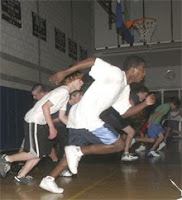It is a series of 50 shots. Players have to "pass" with a minimum score of 35 out of 50 on five separate occasions. They do not have to be 5 consecutive (in a row). Players can only shoot for their license once in a given day. The series is as follows:
1. SET SHOTS - Five spots on the floor: deep corners, freethrow line extended wings, and top of the key. The shooter rotates shooting around the horn, shoot twice in the opposite corner and come back around the horn returning to the original corner. The passer (coach or manager) stays one spot ahead of the shooter. 10 shots. Record the makes.
2. BREAKOUT CATCH AND SHOOT - Using the same five spots, the shooter starts underneath the basket. The shooter sprints to the corner, catches, squares, and shoots. The shooter then sprints back under the basket, sprints to the wing, catches, squares, and shoots. The shooter goes around the horn, shooting twice in the opposite corner, and comes back around returning to the original corner. The passer stays one spot ahead of the shooter. 10 shots. Record the makes and add to the set shots total.
3. WING FAST BREAK CATCH AND SHOOT - Starting at halfcourt on one side of the floor, the shooter sprints to the hashmark (28 foot line), breaks to the arc at a 45 degree angle for the shot. The passer stays in the middle of the floor. 5 times on each side. 10 shots. Record and add to the total.
4. WING FAST BREAK ONE DRIBBLE PULL UPS - Same as above except that the passer must deliver the pass early (get it to the shooter at the hashmark). The shooter catches, one hard dribble, and shoots. 5 times on each side. 10 shots. Record and add to the total.
5. TOP OF THE KEY FAST BREAK CATCH AND SHOOT - The shooter starts in the middle of the jump circle. The passer is on the wing. The shooter sprints opposite the passer, setting up his cut, plants and sprints to the top of the key for a shot. 5 times on each side. 10 shots. Record and add to the total.
The license system brings the cream to the top. It helps the other players on the team recognize who shooters are. When I have used this in the past, it helped to define roles within a team setting. When running zone offenses, for example, I could quickly point out who we wanted to find within our scheme.
In my first season at Eastern Washington we had a player shoot for his license every day of the season. He "passed" the test 4 times going into the last week of the regular season. He was not allowed to shoot a 3-pointer throughout the season. He finally "passed" the test for the fifth time on the Tuesday before our last regular season weekend. I don't recall if he shot a 3 in our last two games that year, but I do remember the sense of accomplishment that this young man felt and the additional confidence it provided him.












